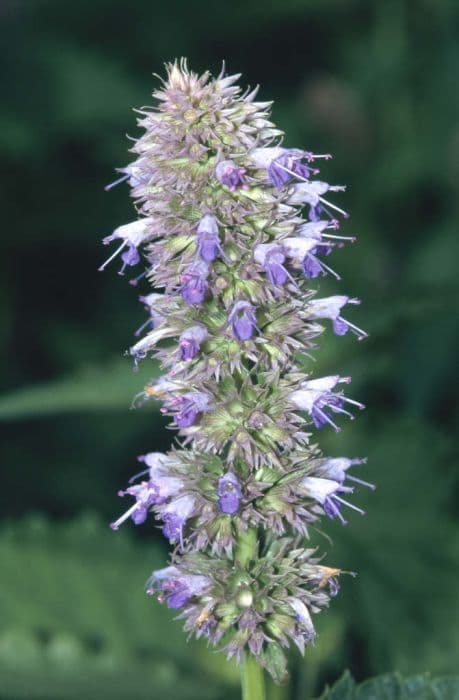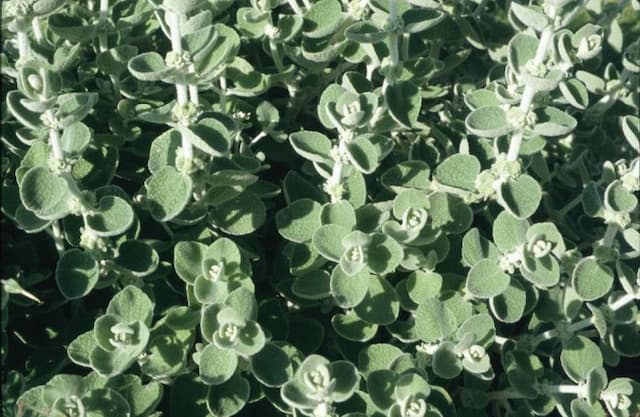Marrubium vulgare 'Green Pompon'

ABOUT
The plant known as 'Green Pompon' horehound showcases distinct characteristics that make it easily recognizable. Its leaves are wrinkled and have a rounded shape, often resembling crinkled mint leaves, but with a thicker and woollier texture. The color of the foliage is a soft, silvery green, giving the plant a fuzzy appearance due to the fine hairs that cover the leaves. These hairs help the plant conserve moisture and fend off pests. The 'Green Pompon' variety is unique for its dense, round clusters of tiny white flowers that bloom in spherical, pompom-like formations. These flowers are tightly packed together at the tips of branching stems, creating a visually appealing contrast with the velvety leaves beneath them. The overall appearance of the plant is quite lush and robust, with its dense foliage providing a backdrop for the delicate flowers that attract pollinators like bees and butterflies. The aromatic scent of the horehound is released when the leaves are crushed, releasing a strong, pungent smell that is hard to miss.
About this plant
 Names
NamesFamily
Lamiaceae.
Synonyms
Horehound, White Horehound, Common Horehound, Hoarhound, Marrubio.
Common names
Marrubium vulgare
 Toxicity
ToxicityTo humans
Horehound, the most common name for Marrubium vulgare 'Green Pompon' is generally considered to be non-toxic to humans. It has been used traditionally for medicinal purposes. However, excessive consumption of any part of this plant may lead to negative side effects due to its potent active ingredients. Horehound contains compounds such as marrubiin which can cause vomiting, diarrhea, and an increased heart rate if consumed in large amounts. It is always wise to use medicinal plants with caution and consult with a healthcare provider before use.
To pets
Horehound is not commonly listed as toxic to pets, including dogs and cats. It is generally considered safe in small amounts, particularly since it has been used historically in herbal medicine for various purposes. Nonetheless, care should be taken as pets may have individual sensitivities or allergic reactions to this plant. Ingesting large amounts may cause gastrointestinal upset in some pets. If a pet has consumed a large quantity of horehound or is showing signs of distress, it is important to contact a veterinarian.
 Characteristics
CharacteristicsLife cycle
Perennials
Foliage type
Deciduous
Color of leaves
Green
Flower color
White
Height
1-2 feet (30-60 cm)
Spread
1-2 feet (30-60 cm)
Plant type
Herb
Hardiness zones
4-9
Native area
Europe
Benefits
 General Benefits
General Benefits- Attracts Pollinators: The plant produces flowers that are appealing to bees and butterflies, enhancing pollinator activity in the garden.
- Drought Tolerance: Once established, it has a good tolerance for drought, making it suitable for xeriscaping or in areas with water restrictions.
- Low Maintenance: Requires minimal care once established, as it is generally resistant to pests and diseases.
- Herbal Uses: Though excluding medical properties, it can still be used for culinary purposes, in teas or as a flavoring.
- Landscape Texture: The 'Green Pompon' variety adds a unique texture to garden beds and borders with its dense, rounded foliage.
- Deer Resistance: The plant is not particularly appealing to deer, making it a good choice for gardens in areas with high deer populations.
- Erosion Control: Its root system can help to stabilize soil and prevent erosion on slopes and banks.
- Aesthetic Appeal: The plant has an ornamental quality, with its spherical, bright green foliage adding visual interest to the landscape.
 Medical Properties
Medical Properties- Expectorant: Helps to expel mucus from the respiratory tract.
- Antispasmodic: Relaxes muscle spasms, particularly in the digestive and respiratory systems.
- Antiseptic: Can inhibit the growth of microorganisms and prevent infection.
- Carminative: May aid in relieving flatulence and bloating.
- Digestive aid: Traditionally used to stimulate appetite and support digestion.
- Antioxidant: Contains compounds that may combat oxidative stress in the body.
- Diaphoretic: Promotes perspiration, which can help in reducing fevers.
- Anti-inflammatory: Potential to reduce inflammation and soothe irritated tissues.
- Vermifuge: Used historically to expel parasitic worms from the body.
- Hepatoprotective: May offer protection to the liver and support liver health.
 Air-purifying Qualities
Air-purifying QualitiesThis plant is not specifically known for air purifying qualities.
 Other Uses
Other Uses- Horticulture: Marrubium vulgare 'Green Pompon' is often used as an ornamental plant in gardens due to its unique spherical green flowers and attractive foliage, making it a good choice for gardeners looking to add texture and variety to their plantings.
- Insect Repellent: Some gardeners plant horehound as a companion plant because its strong smell can deter certain insects from bothering nearby plants.
- Biodegradable Pots: The fibrous material from the stems can be processed into a pulp and molded into biodegradable seedling pots.
- Natural Dye: Horehound can be used to produce a natural brown dye for fabrics, yarns, and crafts.
- Beverage Flavoring: Although not the primary use, horehound has been occasionally used to add a bitter flavor to homemade beers and liqueurs in small quantities for personal consumption.
- Culinary Garnish: The unique flowers of horehound can be used as an elegant garnish for specialty dishes in high-end gastronomy.
- Wildlife Habitat: When grown in natural settings, horehound can provide habitat and food for certain wildlife, including beneficial insects and birds.
- Fragrance Production: Essential oils derived from horehound can be used in the manufacture of natural fragrances for soaps and candles.
- Educational Tool: Horehound is used in educational gardens to teach about medicinal herb history, excluding current medical uses.
- Photography Subject: With its visually compelling structure, horehound can serve as an excellent subject for botanical photography and art.
Interesting Facts
 Feng Shui
Feng ShuiThe Horehound is not used in Feng Shui practice.
 Zodiac Sign Compitability
Zodiac Sign CompitabilityThe Horehound is not used in astrology practice.
 Plant Symbolism
Plant Symbolism- Protection: Marrubium vulgare, commonly known as horehound, has been associated with protection due to its historical use in herbal medicine to ward off illness.
- Healing: The plant is reputed for its healing properties and is symbolic of health and recovery, reflecting its use in treating respiratory issues and digestive problems.
- Mental Clarity: Horehound is also seen as a symbol for mental clarity and sharpness, perhaps because of its bitter taste which is thought to stimulate the mind.
- Exorcism: In some folklore, horehound is said to have the power to ward off evil spirits, making it a symbol for exorcism and spiritual cleansing.
- Detachment: With its ability to help clear the mind and promote a sense of calm, horehound symbolizes detachment from negative thoughts or troublesome matters.
 Water
WaterHorehound, commonly referred to as Marrubium vulgare 'Green Pompon', requires moderate watering. It's best to water the soil when it feels dry to the touch, which typically means watering once every 7 to 10 days, depending on the climate and soil drainage. Water the plant deeply, providing about 1 gallon of water per square foot of soil, ensuring the water penetrates the root zone. It's important to avoid overwatering, as horehound prefers drier conditions and is drought-tolerant once established. During the growing season, in hotter and drier periods, you may need to water more frequently, but always check the soil moisture beforehand.
 Light
LightHorehound thrives in full sun to partial shade, so it is best to place Marrubium vulgare 'Green Pompon' in a spot where it will receive at least 6 hours of sunlight a day. If you're growing it indoors, choose a bright windowsill or a room with ample natural light. Outdoor plants will perform their best in an open area that is not shaded by trees or buildings.
 Temperature
TemperatureHorehound is quite hardy and can tolerate a wide range of temperatures, but Marrubium vulgare 'Green Pompon' grows best in temperatures between 50°F and 80°F. It can withstand minimum temperatures down to about 10°F, but frost can damage the foliage. The plant prefers a cooler climate and may struggle in areas with extreme heat over 90°F.
 Pruning
PruningPruning horehound, or Marrubium vulgare 'Green Pompon', helps maintain its shape and encourages bushier growth. Cut back the plant by one-third in early spring before new growth starts. Prune again after flowering to prevent the plant from becoming woody and to stimulate a second flush of growth. Deadheading, or the removal of spent flowers, is also recommended to promote more blooms.
 Cleaning
CleaningAs needed
 Soil
SoilHorehound (Marrubium vulgare 'Green Pompon') thrives in well-draining soil with a mix of sand, loam, and compost, ideally with a pH range of 6.0 to 7.5. A recipe for its best soil mix could be two parts garden soil, one part sand, and one part compost or aged manure to provide nutrients.
 Repotting
RepottingHorehound should be repotted every 1 to 2 years to provide fresh nutrients and to accommodate its growing root system. Repot in the spring before the onset of the active growing season.
 Humidity & Misting
Humidity & MistingHorehound prefers low to moderate humidity levels and is quite tolerant to dry air; however, it should not be placed in excessively dry environments for prolonged periods.
 Suitable locations
Suitable locationsIndoor
Place horehound in bright light, avoid overwatering, ensure good airflow.
Outdoor
Plant horehound in full sun, well-draining soil, and space plants 30 cm apart.
Hardiness zone
4-9 USDA
 Life cycle
Life cycleMarrubium vulgare 'Green Pompon', commonly known as Horehound, begins its life cycle with seed germination, often occurring in spring when soil temperatures warm up. The seedlings emerge and establish a basal rosette of leaves, and as the plant matures, it develops a sturdy, square stem indicative of its membership in the mint family. During its vegetative stage, Horehound produces woolly, wrinkled leaves and forms a dense, rounded shape. By late spring to early summer, it enters the reproductive phase, flowering with small, white blooms arranged in dense globular whorls along the stem. After pollination, typically by bees and other insects, it sets seed that can be dispersed by wind or animal activity. Horehound is a perennial herb, and once established, it can reproduce and survive through multiple seasons, with some plants living several years.
 Propogation
PropogationPropogation time
Spring-Early Summer
Propogation: Horehound, Marrubium vulgare 'Green Pompon', is typically propagated through seed sowing. The most popular method is to start the seeds indoors about 6 to 8 weeks before the last expected frost. Fill a seed tray with well-draining soil, sprinkle the tiny seeds on the surface, and lightly press them into the soil without covering them as they need light to germinate. Keep the soil moist but not waterlogged, and maintain a temperature around 70°F (about 21°C). Seedlings should emerge in 1 to 2 weeks and can be transplanted outdoors in well-drained soil once the risk of frost has passed and seedlings are strong enough to handle. This method allows for a controlled environment, improving the germination rate and the eventual establishment of the plants in the garden.









